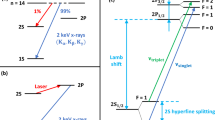Abstract
We discuss main experimental works, where dipole polarizabilities of charged pions have been determined. Possible reasons for the differences between the experimental data are discussed. In particular, it is shown that the account of the -meson gives a significant correction to the value of the polarizability obtained in the latest experiment of the COMPASS collaboration.
Similar content being viewed by others
References
I. Guiasu and E. E. Radescu, “Higher multipole polarizabilities of hadrons from Compton scattering amplitudes”, Ann. Phys. 120, 145–174 (1979).
L. V. Fil’kov and V. L. Kashevarov, “Determination of meson quadrupole polarizabilities from the process γγ → π0π0”, Phys. Rev. C 72, 035211 (2005).
J. Ahrens, V. M. Alexeev, J. R. M. Annand, H. J. Arends, R. Beck, G. Caselotti, S. N. Cherepnya, D. Drechsel, L. V. Fil’kov, K. Föhl, I. Giller, P. Grabmayer, T. Hehl, D. Hornidge, V. L. Kashevarov, M. Kotulla, D. Krambrich, B. Krusche, M. Lang, J. C. McGeorge, I. J. D. MacGregor, V. Metag, M. Moinester, R. Novotny, M. Pfeiffer, M. Rost, S. Schadmand, S. Scherer, A. Thomas, C. Unkmeir and Th. Walcher, “Measurement of the -meson polarizabilities via the γp → γπ+ n reaction”, Eur. Phys. J. A 23, 113–127 (2005).
T. A. Aibergenov, P. S. Baranov, O. D. Beznisko, S. N. Cherepnija, L. V. Fil’kov, A. A. Nafikov, A. I. Osadchiy, V. G. Raevskiy, L. N. Shtarkov, and E. I. Tamm, “Radiative photoproduction of pions and pion Compton scattering”, Czech. J. Phys. B 36, 948–951 (1986).
Yu. M. Antipov, V. A. Batarin, V. A. Bessubov, N. P. Budanov, Yu. P. Gorin, S. P. Denisov, I. V. Kotov, A. A. Lebedev, A. I. Petrukhin, S. A. Polovnikov, V. N. Roinishvili, D. A. Stoyanova, P. A. Kulinich, G. V. Mecel’macher, A. G. Ol’shevski, and V. I. Travkin, “Measurement of π−-meson polarizability in pion Compton effect”, Phys. Lett. B 121, 445–448 (1983).
C. Adolph et al. (COMPASS Collab.), “Measurement of the charged-pion polarizability”, Phys. Rev. Lett. 114, 062002 (2015).
D. Babusci, S. Bellucci, G. Giordano, G. Matone, A. M. Sandorfi, and M. A. Moinester, “Chiral symmetry and pion polarizabilities”, Phys. Lett. B 277, 158–162 (1992).
C. Berger et al. (PLUTO Collab.), “Pion pair production in photon-photon interactions”, Z. Phys. C 26, 199–207 (1984).
A. Courau, A. Falvard, J. Haissinski, J. Jousset, B. Michel, J. C. Montret, A. Cordier, B. Delcourt, and F. Mane, “Lepton and pion pair production in collisions measured near the threshold at DCI”, Nucl. Phys. B 271, 1–20 (1986).
J. Boyer et al. (Mark II Collab.), “Two-photon production of pion pairs”, Phys. Rev. D 42, 1350–1367 (1990).
J. F. Donoghue and B. R. Holstein, “Photon-photon scattering, pion polarizability, and chiral symmetry”, Phys. Rev. D 48, 137–146 (1993).
A. E. Kaloshin and V. V. Serebryakov, “π+ and π0 polarizabilities from γγ → ππ data”, Z. Phys. C 64, 689–694 (1994).
L. V. Fil’kov and V. L. Kashevarov, “Determination of π+ meson polarizabilities from the γγ → π+π− process”, Phys. Rev. C 73, 035210 (2006).
H. Aihara et al. (TPC/Two-Gamma Collab.), “Pion and kaon pair production in photon-photon collisions”, Phys. Rev. Lett. 57, 404–407 (1986).
H. J. Behrend et al. (CELLO Collab.), “An experimental study of the process γγ → π+π−”, Z. Phys. C 56, 381–390 (1992).
Yabuki Fumiaki et al. (VENUS Collab.), “Study of π+π− pair production in a two-photon process at TRISTAN”, J. Phys. Soc. Jpn. 64, 435–447 (1995).
A. Heister et al. (ALEPH Collab.), “Exclusive production of pion and kaon meson pairs in two photon collisions at LEP”, Phys. Lett. B 569, 140–150 (2003).
H. Nakazawa et al. (Belle Collab.), “Measurement of the γγ → π+π− and γγ → K + K − processes at energies of 2.4–4.1 GeV”, Phys. Lett. B 615, 39–49 (2005).
R. Garcia-Martin and B. Moussallam, “MO analysis of the high statistics belle results on γγ → π+π−, π0π0 with chiral constraints”, Eur. Phys. J. C 70, 155–175 (2010).
L. V. Fil’kov and V. L. Kashevarov, “Compton scattering on the charged pion and the process γγ → π0π0”, Eur. Phys. J. A 5, 285–292 (1999).
I. Giller, “Pion polarizability measurement via radiative pion photoproduction”, Ph. D. Thesis (Tel Aviv University, 2004).
J. Gasser, M. A. Ivanov, and N. E. Sainio, “Revisiting γγ → π+π− at low energies”, Nucl. Phys. B 745, 84–108 (2006).
U. Bürgi, “Pion polarizabilities and charged pion-pair production to two loops”, Nucl. Phys. B 479, 392–426 (1996).
L. Fil’kov and V. Kashevarov, “Dispersion sum rules for pion polarizabilities”, Proc. of Intern. Workshop on Chiral Dynamics (Bern, 2009), PoS (CD09), p. 036.
I. Ya. Pomeranchuk and I. M. Shmushkevich, “On processes in the interaction of -quanta with unstable particles”, Nucl. Phys. 23, 452–467 (1961).
G. Fäldt and U. Tengblad, “Hard pion Bremsstrahlung in the Coulomb region”, Phys. Rev. C 76, 064607 (2007).
G. Fäldt and U. Tengblad, “Coulomb-nuclear interference in pion-nucleus Bremsstrahlung”, Phys. Rev. C 79, 014607–014627 (2009); Phys. Rev. C 87, 029903(E) (2013).
Th. Walcher, “Hadron structure at small momentum transfer”, Progr. Part. Nucl. Phys. 61, 106–112 (2008).
U. Amaldi, M. Jacob, and G. Matthiae, “Diffraction of hadronic waves”, Ann. Rev. Nucl. Part. Sci. 26, 385–456 (1976).
Th. Walcher, Private communication.
H. A. Abarbanel and M. L. Goldberger, “Low-energy theorems, dispersion relations, and superconvergence sum rules for Compton scattering”, Phys. Rev. 165, 1594–1609 (1968).
J. A. Oller and L. Roca, “Two photon into π0π0”, Eur. Phys. J. A 37, 15–22 (2008).
M. R. Pennington, “Sigma coupling to photons: Hidden scalar in γγ → π0π0”, Phys. Rev. Lett. 97, 011601 (2006).
J. Bijnens and F. Cornet, “Two-pion production in photon-photon collisions”, Nucl. Phys. B 296, 557–568 (1988).
M. Hoferichter, D. R. Phillips, and C. Schat, “Roy- Steiner equations for γγ → ππ”, Eur. Phys. J. C 71 (1743), 1–28 (2011).
Author information
Authors and Affiliations
Corresponding author
Additional information
The article is published in the original.
Rights and permissions
About this article
Cite this article
Fil’kov, L.V., Kashevarov, V.L. Dipole polarizabilities of charged pions. Phys. Part. Nuclei 48, 117–123 (2017). https://doi.org/10.1134/S1063779617010063
Published:
Issue Date:
DOI: https://doi.org/10.1134/S1063779617010063




